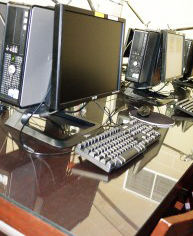 Proper pronunciation, intonations, and stresses are integral parts of learning a language. Sunah Cho, a sessional instructor for the Asian Studies department, is well aware of the fact. In her Korean 102 class, a 6-credit beginner level class for non-heritage students, she uses the web-based Wimba Voice Tools to assist students in developing their verbal skills in Korean language learning.
Proper pronunciation, intonations, and stresses are integral parts of learning a language. Sunah Cho, a sessional instructor for the Asian Studies department, is well aware of the fact. In her Korean 102 class, a 6-credit beginner level class for non-heritage students, she uses the web-based Wimba Voice Tools to assist students in developing their verbal skills in Korean language learning.
As a learning tool, Wimba facilitates and promotes vocal instruction, collaboration and assessment. With the use of threaded voice boards, Sunah and her teaching assistant, Jeehun Kim, post weekly online assignments for students to listen to. They could receive two types, either reading assignments that ask them to read text or speaking/dialogue assignments requiring students to have guided replies to sample conversations. Answers are then recorded and posted online. Sunah and Jeehun provide feedback after reviewing their posts. Sunah also encourages student interaction in Wimba through a Free Talk section. A forum for student communication, they can discuss study strategies and organize typing or oral practices. Participation is voluntarily and students can post any class-related issues.
According to Sunah, one of Wimba’s best features is the ability to create asynchronous conversations between instructors and students. It gives the flexibility to continue learning without the pressure of fixed schedules. There is no need to organize meetings or practice sessions outside regular class hours. She says, however, that Wimba is designed to maximize the potential for student engagement, not to replace student-instructor interaction. In her class, students are not expected to reply to Sunah and Jeehun’s feedback. Instead, they create new responses that incorporate her corrections and suggestions.
Some studies have shown that the use of Wimba reduces the anxiety level in student participation. Students can review their replies to assignments as much as they desire before posting them on the thread boards. They are able to detect their own errors and improve upon them. A feedback survey shows that Sunah’s students review their replies an average of 4 – 5 times. Their posts are also available to everyone in the class, allowing them to hear each other’s responses. It encourages them to practice and learn from others.
Even though student responses have been very positive, there are still areas for improvement. One of them is the use of Asian characters in the text. Korean characters are not well defined and font sizes tend to be small. Sunah also suggests a more user-friendly interface and the incorporation of message alerts. Currently, students need to go into message boards in order to check if a new assignment has been posted.
One of the most difficult aspects of learning a language is properly expressing your ideas in the correct manner. In many instances, this can only be achieved through the subtle differences of intonations and pronunciation. Wimba is a tool that can help students learn a language better than a book can do alone.

